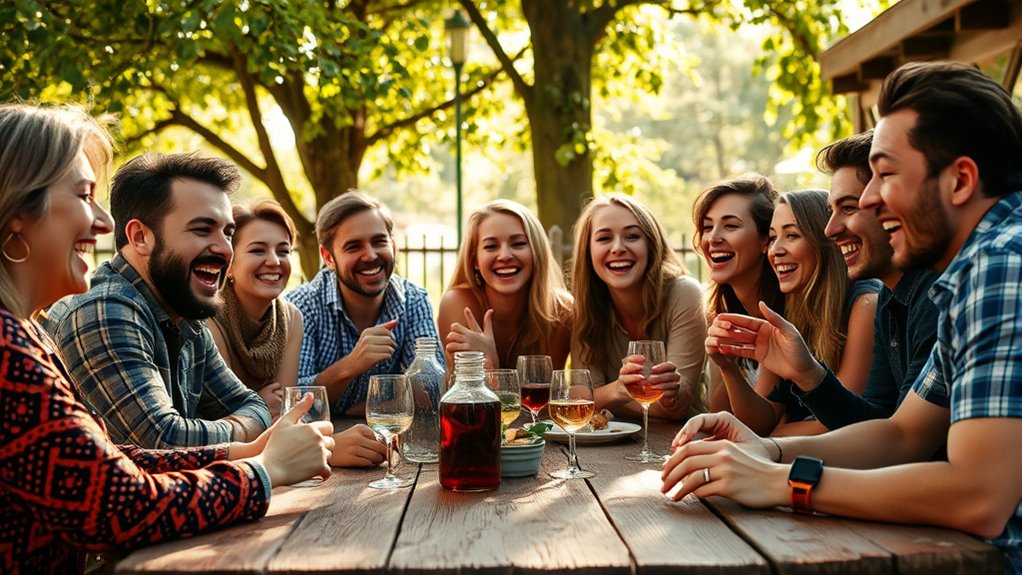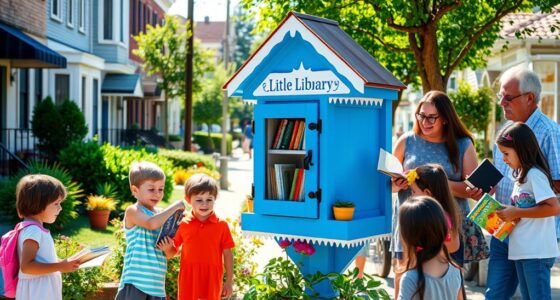Shared laughter triggers emotional and social cues that cause your heartbeats to synchronize. When you laugh with others, your breathing and heart rates align through neural, hormonal, and physiological responses. This connection fosters trust, empathy, and emotional bonds. Heartbeat synchronization isn’t just a coincidence – it’s a powerful way laughter deepens connections. If you stay curious, you’ll discover how these interactions strengthen relationships and promote well-being in ways you might not expect.
Key Takeaways
- Laughter triggers respiratory and cardiovascular responses, aligning breathing patterns and causing temporary heart rate synchronization.
- Shared laughter activates neural pathways, including mirror neurons, promoting emotional mirroring and synchronized heart rhythms.
- Physiological responses during laughter reduce stress and promote emotional bonding through heart rate and heartbeat variability alignment.
- Social cues communicated via the nervous system facilitate heart rhythm coupling during shared joyful experiences.
- Activities like laughter yoga enhance bodily synchronization, strengthening social bonds through synchronized heartbeats.
The Science Behind Laughter and Heart Rate

Laughter triggers a complex response in your body that directly affects your heart rate. When you laugh, your brain stimulates your respiratory and cardiovascular systems, leading to what’s called musical synchronization—your breathing and heartbeat start to align. This synchronized breathing causes your heart to beat more evenly, reducing stress and promoting relaxation. As your breathing speeds up and then slows down during laughter, your heart adjusts its rhythm accordingly, creating a temporary synchronization between the two. This process isn’t just coincidental; it’s a biological response that enhances feelings of connection and well-being. Interestingly, engaging in activities that promote emotional health can also positively influence your heart rhythm and overall cardiovascular health. By engaging these systems through laughter, your body promotes a healthier heart rhythm and sparks a sense of unity within yourself.
How Social Interactions Influence Our Biological Responses

When you engage socially, your emotional states often mirror those around you, creating a shared experience. This mirroring leads to synchronization of physiological responses, like heartbeat and breathing. As a result, social interactions can strengthen bonds and foster a sense of connection. Additionally, indoor air quality can influence overall well-being during these interactions, making healthy indoor environments an important aspect of social comfort.
Mirroring Emotional States
Social interactions often trigger a remarkable phenomenon: as you respond emotionally to others, your biological responses mirror their feelings. When someone laughs, your heart rate may quicken; when they’re upset, your cortisol levels can rise. Cultural differences shape how emotions are expressed and perceived, influencing your reactions. For example, humor perception varies globally—what sparks laughter in one culture might not in another—yet your body still reacts accordingly. To visualize this, imagine the following:
| Emotional Response | Physiological Reaction |
|---|---|
| Joy from a joke | Heartbeat speeds up |
| Sympathy for a friend | Stress hormones rise |
| Discomfort from an awkward silence | Muscle tension increases |
| Shared humor | Synchronization of responses |
This mirroring deepens social bonds, aligning your biological state with others’ emotions. Additionally, recognizing preppy dog names can reflect your personality and style, much like how social bonds are reinforced through emotional mirroring.
Synchronization of Physiology
During social interactions, our bodies often synchronize their physiological responses, creating a shared biological rhythm that enhances connection. This synchronization isn’t uniform across cultures; cultural differences influence how people respond to laughter and social cues, shaping physiological reactions. For example, some cultures emphasize collective laughter through laughter therapy, which actively promotes bodily alignment, including synchronized heartbeat and breathing patterns. Such practices demonstrate that shared laughter can directly impact biological responses, fostering a sense of unity and trust. When you laugh together, your heart rate may align with others’, strengthening social bonds. This physiological synchronization underscores how social interactions, rooted in cultural context, influence your body’s biological responses, making shared laughter more than just an emotional experience—it becomes a physical one that deepens social ties. Additionally, engaging in laughter therapy has been shown to further enhance this synchronization, highlighting the profound connection between shared social activities and biological responses.
Boosting Social Bonding
Engaging in social interactions can substantially enhance your biological responses, strengthening feelings of connection and trust. Activities like laughter therapy encourage shared joy, releasing endorphins that foster bonding. When you laugh together, your brain engages in social mimicry—subconsciously mirroring each other’s gestures and expressions—which deepens emotional ties. This mimicry promotes synchronization of physiological responses, such as heartbeats, reinforcing social bonds. Laughter therapy isn’t just fun; it’s a powerful tool to boost social cohesion. By intentionally participating in these activities, you activate your body’s natural mechanisms for building trust and empathy. The rhythmic nature of shared laughter and mimicry helps align your physiological states with others, making social interactions more meaningful and strengthening your sense of belonging. Recognizing the importance of inspirational quotes about fatherhood can further inspire connections rooted in love and support.
The Mechanics of Heartbeat Synchronization

Heartbeat synchronization occurs when your heart rates align through interaction, often driven by emotional and physiological connections. Cultural influences shape how and when this synchronization happens, affecting social norms around shared experiences like laughter or conversation. Individual differences, such as stress levels, emotional states, or personality traits, also play a role, making some people more prone to syncing their heartbeats than others. When you share a moment of genuine connection, your nervous systems communicate via subtle cues, leading to synchronized heart rhythms. This process isn’t purely mechanical; it involves complex neural and hormonal pathways that respond to social stimuli. Factors like emotional attunement can enhance the likelihood of heartbeat synchronization, emphasizing how deeply intertwined our physiological responses are with social bonding. Understanding these mechanics shows how deeply intertwined our physiological responses are with social bonding, highlighting the importance of shared experiences in fostering connection.
Studies Demonstrating Heartbeat Alignment During Shared Laughter

Research shows that shared laughter can lead to measurable synchronization of heartbeats between individuals. Studies using methods like music therapy and laughter yoga reveal that when people laugh together, their heart rates often align temporarily. For example, experiments involving laughter yoga sessions demonstrate increased heart rate coupling among participants, highlighting the physiological effects of shared humor. Similarly, research into music therapy sessions shows that communal laughter enhances physiological synchrony, supporting the idea that laughter acts as a social bonding mechanism. These findings suggest that the act of laughing together doesn’t just lift spirits but also produces real, observable changes in heart rhythm coordination, emphasizing laughter’s role in fostering connection and physiological harmony. Additionally, automation technologies in healthcare are being explored to monitor and enhance social bonding through physiological data analysis.
Emotional Connection and Physiological Synchrony

When you share laughter with someone, your bond grows stronger and emotional closeness deepens. This connection often leads to your heart rates mirroring each other, reflecting a physiological link. As your emotional ties strengthen, so does the synchronization between your bodies, reinforcing your relationship. Additionally, high refresh rates in visual experiences can enhance enjoyment and immersion, much like shared laughter enhances emotional connection.
Shared Laughter Enhances Bond
Shared laughter acts as a powerful social glue that deepens emotional bonds between individuals. It breaks down barriers, fostering trust and a sense of connection. Cultural differences may influence how people laugh, but the positive effects remain universal. Participating in laughter therapy, for example, demonstrates how shared humor can strengthen relationships across diverse backgrounds. When you laugh together, your bodies release feel-good hormones, reinforcing feelings of closeness. This emotional boost encourages openness and vulnerability, making interactions more meaningful. Over time, shared laughter cultivates empathy and mutual understanding, solidifying your bond. Whether in casual conversations or structured laughter exercises, the act of laughing together creates a shared experience that enhances both emotional intimacy and physiological connection. Additionally, engaging in shared laughter can also promote overall well-being by reducing stress hormones and boosting immune function, highlighting its health benefits.
Mirrored Heart Rates Occur
Laughter not only boosts your mood but also synchronizes physiological responses between people. When you share a genuine laugh, your heart rates tend to mirror each other’s, creating a sense of connection. This phenomenon, linked to emotional closeness, is often observed in laughter therapy sessions, where participants’ heart rate variability becomes aligned. You might notice:
- Your pulse speeds up or slows down in sync with someone else’s
- Breathing patterns match during shared laughter
- Heartbeats become more coordinated over time
- Emotional bonds deepen through this physiological link
- The experience fosters feelings of trust and safety
- Physiological synchrony highlights how laughter fosters physiological synchrony, strengthening bonds without words. Your body responds instinctively, reinforcing emotional ties through shared moments of joy.
Emotional Closeness Strengthens
As emotional closeness deepens, your physiological responses become more synchronized, reinforcing the bond between you and others. Laughter therapy is a powerful tool that enhances this connection, promoting shared joy and trust. When you laugh together, your heart rhythms align more closely, a process confirmed through heart rhythm analysis. This physiological synchrony reflects a stronger emotional link, making interactions more meaningful. As you engage in shared laughter, your bodies respond in harmony, boosting feelings of intimacy and understanding. Research shows that the more emotionally connected you are, the easier it becomes for your heartbeats to synchronize during moments of joy or humor. This natural alignment deepens your relationship, creating a cycle of mutual emotional and physiological resonance.
The Role of Mirror Neurons in Emotional and Physical Mirroring

Mirror neurons play a essential role in how we naturally imitate and understand others’ emotions and actions. These neurons activate both when you perform an action and when you observe someone else doing it, fostering empathy and connection. This process enhances neural plasticity, allowing your brain to adapt and strengthen social bonds. In laughter therapy, for instance, these neurons help you feel and mirror the joy shared with others, deepening emotional ties. When you laugh together, your mirror neurons synchronize your responses, promoting physical mirroring like synchronized heartbeats. To understand this better:
- They enable emotional resonance during shared experiences
- They support physical mirroring, like synchronized breathing
- They strengthen social bonds through imitation
- They make laughter contagious
- They adapt through neural plasticity, improving social skills
This neural mirroring underpins how shared laughter fosters deep connection.
Benefits of Heartbeat Synchronization for Relationships

Heartbeat synchronization deeply enhances your relationships by fostering a sense of unity and emotional intimacy. When your heartbeats align, you naturally feel more connected and empathetic toward others. Laughter therapy and shared joyful moments strengthen group dynamics, creating a bond that’s resilient and genuine. This synchronized rhythm promotes trust and reduces emotional distance, making interactions more meaningful. Consider how shared laughter during conversations or activities can lead to a collective heartbeat, deepening your connection. Here’s a quick look at the benefits:
| Benefit | How It Helps | Example |
|---|---|---|
| Emotional closeness | Builds trust and understanding | Sharing jokes in groups |
| Reduced stress | Calms nervous system | Group laughter therapy |
| Group cohesion | Enhances teamwork | Collaborative activities |
| Empathy | Increases emotional resonance | Listening and mirroring |
| Joy and bonding | Strengthens overall bonds | Celebratory moments |
Practical Implications for Enhancing Social Bonds

To effectively strengthen social bonds, you can incorporate activities that promote shared experiences and synchronized rhythms, such as group laughter exercises or rhythmic breathing practices. These activities foster connection, even across cultural differences, by creating a common, physiological language. Keep in mind that humor perception varies among cultures, so choose universally inclusive jokes or playful interactions. Engaging in synchronized activities encourages trust and empathy, boosting emotional closeness. Here are some tips to get started:
- Use light-hearted, inclusive humor to accommodate diverse backgrounds
- Practice group breathing exercises to align physiological rhythms
- Participate in laughter yoga or improvisation activities
- Share funny stories that resonate across cultures
- Be attentive to cues that indicate comfort or discomfort
These approaches help deepen bonds and foster mutual understanding.
Future Research Directions in Laughter and Physiological Connectivity

Building on current insights into how shared laughter enhances social bonds through physiological synchronization, future research can explore the nuanced mechanisms underlying these connections. Investigating how laughter therapy influences heart rate variability and stress reduction could provide deeper understanding of its therapeutic benefits. Future studies might examine whether intentional laughter interventions foster stronger physiological links across diverse populations, including those with mental health challenges. Additionally, exploring the neural pathways involved in laughter-induced synchronization can uncover how social and emotional factors drive physiological responses. By clarifying these mechanisms, researchers can develop targeted laughter-based interventions to promote stress relief and emotional well-being. This line of inquiry promises to expand practical applications, making laughter therapy more effective in fostering social cohesion and reducing stress-related health issues.
Frequently Asked Questions
Can Heartbeat Synchronization Occur During Activities Other Than Laughter?
Heartbeat synchronization can happen during activities beyond laughter, especially when emotional contagion occurs. When you’re part of a group experiencing strong emotions, your heartbeats may start to align, strengthening group cohesion. Activities like singing, dancing, or even intense conversations can create this effect. You might notice your pulse syncing with others, making you feel more connected and in sync with the group’s mood, fostering a sense of unity.
How Long Does Heartbeat Alignment Last After Shared Laughter Ends?
After shared laughter ends, heartbeat duration synchronization typically lasts a few minutes during laughter recovery. Your heart rates may stay aligned briefly as your body shifts from the laughter’s physiological effects back to normal. The duration varies based on factors like emotional connection and activity intensity. Generally, the longer you share laughter, the more sustained the heartbeat synchronization, but it gradually diminishes during laughter recovery as your bodies return to baseline.
Does Individual Temperament Affect Susceptibility to Physiological Synchronization?
Your personality traits and emotional responsiveness influence how susceptible you are to physiological synchronization during shared laughter. If you’re more emotionally responsive and open, you’re likely to experience stronger synchronization, as your body more readily tunes into others’ cues. Conversely, if you’re less responsive or have certain personality traits, this synchronization may be weaker or less consistent. Your individual temperament plays a key role in how deeply you connect physically during social interactions.
Are There Cultural Differences in Heartbeat Synchronization During Social Interactions?
Imagine a world where cultural rituals and emotional expression shape every heartbeat during social interactions. You’d see dance, song, and laughter crossing borders, synchronizing heartbeats like a global symphony. Different cultures emphasize varied ways of connecting through shared joy, making heartbeat synchronization a colorful mosaic. These cultural differences influence how deeply and swiftly your heart aligns with others, highlighting the beautiful diversity in emotional expression worldwide.
Can Heartbeat Synchronization Be Intentionally Cultivated or Enhanced?
You can intentionally cultivate synchronization of heartbeats through practices like shared breathing exercises, mindful meditation, or group activities that promote connection. Engaging in these activities enhances your awareness and fosters intentional synchronization, which can have therapeutic applications by reducing stress and building rapport. By actively participating, you help create a rhythm that aligns with others, strengthening social bonds and promoting emotional well-being through deliberate efforts.
Conclusion
When you share a laugh with someone, your heartbeats naturally synchronize, deepening your connection. This biological mirroring isn’t just a coincidence—it’s a sign of emotional bonding reinforced by mirror neurons. So, next time you find yourself laughing with friends, remember you’re not just having fun; you’re strengthening your relationship on a truly physiological level. Embrace these moments—they’re powerful tools for building stronger, more connected bonds that benefit both your mind and body.










